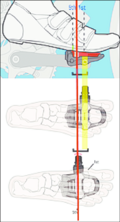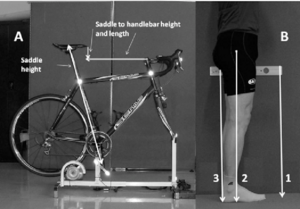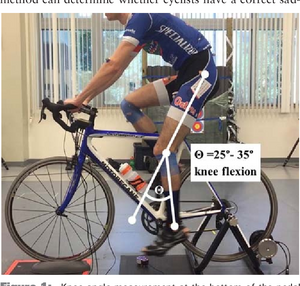Knee Injury Prevention In Cyclist: Difference between revisions
m (Manali K Shah moved page ERGONOMIC ADVICE ON CYCLE SETTING to Ergonomic Advice For Cycle Setting: edited the title with title cases) |
mNo edit summary |
||
| Line 1: | Line 1: | ||
<div class="editorbox"> "Original Editor"-[[User: Manali K Shah| Manali K Shah]] ""Top Contributors""- {{Special:Contributors/{{FULLPAGENAME}}}}</div> | <div class="editorbox"> "Original Editor"-[[User: Manali K Shah| Manali K Shah]] ""Top Contributors""- {{Special:Contributors/{{FULLPAGENAME}}}}</div> | ||
== Introduction | == Introduction == | ||
Bicycle riding is a popular form of sport, recreation, fitness and transportation in many areas of the world. The health benefits of participating in regular physical activity are well established, so now a days recreational cycling activity has been very popular and therefore not surprising that patients presenting with injuries related to cycling may also increase. But many common cycling injuries of the lower extremity are preventable. | Bicycle riding is a popular form of sport, recreation, fitness and transportation in many areas of the world. The health benefits of participating in regular physical activity are well established<ref>Physical activity[Internet]. WHO; 26 Nov 2020. Available from:https://www.who.int/news-room/fact-sheets/detail/physical-activity</ref>, so now a days recreational cycling activity has been very popular and therefore not surprising that patients presenting with injuries related to cycling may also increase. But many common cycling injuries of the lower extremity are preventable. | ||
Studies suggests that cycling is a healthy recreational activity, although it can result in acute and chronic or overuse injuries. Acute injuries may occur due to road traffic accidents which can be prevented by using helmet and following proper traffic rules. But chronic injuries require specific ergonomics and proper physiotherapy guidelines for various factors responsible for injury.<ref name=":0">MP Schwellnus & EW Derman (2005) Common injuries in cycling: Prevention, diagnosis and management, South African Family Practice, 47(7): 14-19</ref> | Studies suggests that cycling is a healthy recreational activity, although it can result in acute and chronic or overuse injuries. Acute injuries may occur due to road traffic accidents which can be prevented by using helmet and following proper traffic rules. But chronic injuries require specific ergonomics and proper physiotherapy guidelines for various factors responsible for injury.<ref name=":0">MP Schwellnus & EW Derman (2005) Common injuries in cycling: Prevention, diagnosis and management, South African Family Practice, 47(7): 14-19</ref> | ||
| Line 11: | Line 11: | ||
== Anatomy of Cycle == | == Anatomy of Cycle == | ||
{{#ev: youtube | VvRUgLCrr0A}} | Following are the parts of cycle explained in the video: | ||
Handlebar, Brake hood, Brake levers, Stem, Seat rails, Head tube, Front brake, Fork, Skewer, Hub, Slick road tires, Brake cable, Top tube, Saddle, Saddle rails, Seatpost, Seat clamp, Seat tube, Down tube, Front derailleur, Crankset, Pedal, Crankset bolt, Chain rings, Rear brake, Spokes, Rear derailleur, Rim and Valve.{{#ev: youtube | VvRUgLCrr0A}} | |||
<ref>https://www.youtube.com/watch?v=VvRUgLCrr0A&t=33s</ref> | <ref>https://www.youtube.com/watch?v=VvRUgLCrr0A&t=33s</ref> | ||
| Line 23: | Line 25: | ||
According to studies following settings should be done to prevent overuse injury for Knee joint in cyclist: | According to studies following settings should be done to prevent overuse injury for Knee joint in cyclist: | ||
# ''' | # '''Keep mid saddle height''' (based on Trochanteric Length Method (100%) or Holmes et al. Method with knee flexion 25 to 30 degrees.) | ||
# ''' | # '''On the pedal surface keep anterior foot position''' (it is defined as the contact with the head of the second metatarsal (ball of foot) and the pedal surface.) | ||
# | # '''Keep the saddle and hand bars at the same height.'''<ref name=":1">Rodrigo Bini, Patria A. Hume and James L. Croft. Effects of Bicycle Saddle Height on Knee Injury Risk and Cycling Performance. Sports Med 2011; 41 (6): 463-476</ref><ref>Dheeraj Lamba, Satish Pant, Girish Chandra. Effect of Saddle Heights on Craniovertebral Angle During Ergonomic Cycling. Indian Journal of Physiotherapy and Occupational Therapy. July-Sep., 2011, 5(3): 157-160</ref>[[File:Position-of-foot-and-shoe-relative-to-pedal-and-cleat-interface-Used-with-permission-of.png|thumb|<ref>https://www.google.com/search?q=anterior+foot+position+of+cleat&tbm=isch&ved=2ahUKEwjKlfaq6aT3AhUD2HMBHY3YBG8Q2-cCegQIABAA&oq=anterior+foot+position+of+cleat&gs_lcp=CgNpbWcQAzoHCCMQ7wMQJzoKCCMQ7wMQ6gIQJzoLCAAQgAQQsQMQgwE6CAgAEIAEELEDOggIABCxAxCDAToFCAAQgAQ6BAgAEEM6BwgAELEDEEM6CggAELEDEIMBEEM6BggAEAUQHjoGCAAQCBAeOgQIABAYUO8EWPFiYM5kaAJwAHgEgAGXAogB-TmSAQcwLjIyLjE1mAEAoAEBqgELZ3dzLXdpei1pbWewAQrAAQE&sclient=img&ei=OyFhYoqMPIOwz7sPjbGT-AY&bih=757&biw=1440#imgrc=umCsu7AEo-cEOM</ref>|alt=|center|222x222px]] | ||
== Measurement of saddle height == | == Measurement of saddle height == | ||
Position of saddle is very important to find the effect of it on cycling performance and knee injury risk for athlete. A | Position of saddle is very important to find the effect of it on cycling performance and knee injury risk for athlete. A various methods have been proposed, some of which are discussed below:<ref name=":1" /> | ||
{| class="wikitable" | {| class="wikitable" | ||
|+[[File:A-Illustration-of-saddle-height-and-saddle-to-handlebar-height-and-length-B-Lower.png|left|thumb|<ref>https://www.google.com/search?q=effects+of+bicycle+saddle+height+on+knee+injury+risk+and+cycling+performance&sxsrf=APq-WBvAatt1H4PYWwRD_A1FBO1SnGSgeQ:1650530688374&source=lnms&tbm=isch&sa=X&ved=2ahUKEwiagfz64aT3AhUgqVYBHX2pC7sQ_AUoAXoECAEQAw&biw=1440&bih=757&dpr=1#imgrc=thyidqqUHRqi5M&imgdii=74L85bRaFNay6M</ref>]][[File:1-Figure1-1.png|left|thumb|<ref>https://www.google.com/search?q=effects+of+bicycle+saddle+height+on+knee+injury+risk+and+cycling+performance&sxsrf=APq-WBvAatt1H4PYWwRD_A1FBO1SnGSgeQ:1650530688374&source=lnms&tbm=isch&sa=X&ved=2ahUKEwiagfz64aT3AhUgqVYBHX2pC7sQ_AUoAXoECAEQAw&biw=1440&bih=757&dpr=1#imgrc=U7aNGIjhXmgJJM</ref>]] | |+[[File:A-Illustration-of-saddle-height-and-saddle-to-handlebar-height-and-length-B-Lower.png|left|thumb|<ref>https://www.google.com/search?q=effects+of+bicycle+saddle+height+on+knee+injury+risk+and+cycling+performance&sxsrf=APq-WBvAatt1H4PYWwRD_A1FBO1SnGSgeQ:1650530688374&source=lnms&tbm=isch&sa=X&ved=2ahUKEwiagfz64aT3AhUgqVYBHX2pC7sQ_AUoAXoECAEQAw&biw=1440&bih=757&dpr=1#imgrc=thyidqqUHRqi5M&imgdii=74L85bRaFNay6M</ref>]][[File:1-Figure1-1.png|left|thumb|<ref>https://www.google.com/search?q=effects+of+bicycle+saddle+height+on+knee+injury+risk+and+cycling+performance&sxsrf=APq-WBvAatt1H4PYWwRD_A1FBO1SnGSgeQ:1650530688374&source=lnms&tbm=isch&sa=X&ved=2ahUKEwiagfz64aT3AhUgqVYBHX2pC7sQ_AUoAXoECAEQAw&biw=1440&bih=757&dpr=1#imgrc=U7aNGIjhXmgJJM</ref>]] | ||
Revision as of 07:48, 25 April 2022
Introduction[edit | edit source]
Bicycle riding is a popular form of sport, recreation, fitness and transportation in many areas of the world. The health benefits of participating in regular physical activity are well established[1], so now a days recreational cycling activity has been very popular and therefore not surprising that patients presenting with injuries related to cycling may also increase. But many common cycling injuries of the lower extremity are preventable.
Studies suggests that cycling is a healthy recreational activity, although it can result in acute and chronic or overuse injuries. Acute injuries may occur due to road traffic accidents which can be prevented by using helmet and following proper traffic rules. But chronic injuries require specific ergonomics and proper physiotherapy guidelines for various factors responsible for injury.[2]
The most common anatomical sites for overuse injury/complaints reported by studies were the back, knees, neck and shoulder, groin and buttocks, and hands.[2][3][4]
Anatomy of Cycle[edit | edit source]
Following are the parts of cycle explained in the video:
Handlebar, Brake hood, Brake levers, Stem, Seat rails, Head tube, Front brake, Fork, Skewer, Hub, Slick road tires, Brake cable, Top tube, Saddle, Saddle rails, Seatpost, Seat clamp, Seat tube, Down tube, Front derailleur, Crankset, Pedal, Crankset bolt, Chain rings, Rear brake, Spokes, Rear derailleur, Rim and Valve.
Risk factors for overuse injury:[edit | edit source]
Incorrect bicycle configuration may predispose athletes to injury and reduce their cycling performance.
The patellofemoral joint is under particular stress in bicycling thus Patellofemoral pain (PFP) is a common overuse injury in cycling. Risk factors for PFP can be divided into extrinsic and intrinsic factors. Extrinsic factors for PFP are incorrect cadence, power output, crank length, saddle forefoot position, saddle height, and foot position.While intrinsic factors for PFP are poor strength of core, pelvic and lower limb muscles and poor flexibility of flexors and extensors of lower kinetic chain.[6]
Ergonomics on cycling setting:[edit | edit source]
According to studies following settings should be done to prevent overuse injury for Knee joint in cyclist:
- Keep mid saddle height (based on Trochanteric Length Method (100%) or Holmes et al. Method with knee flexion 25 to 30 degrees.)
- On the pedal surface keep anterior foot position (it is defined as the contact with the head of the second metatarsal (ball of foot) and the pedal surface.)
- Keep the saddle and hand bars at the same height.[7][8]
Measurement of saddle height[edit | edit source]
Position of saddle is very important to find the effect of it on cycling performance and knee injury risk for athlete. A various methods have been proposed, some of which are discussed below:[7]
| No. | Method | measurement of subject | measurement on cycle | percentage of setting |
|---|---|---|---|---|
| 1. | Hamley and Thomas Method (see fig. 1) | Subject in standing, inseam leg
length measurement. |
saddle to pedal distance | 109% |
| 2. | Trochanteric Length Method (see fig. 1) | Subject in standing, the length from the most prominent bony surface of the greater trochanter to the floor. | saddle to the center of the bottom bracket distance | 100% |
| 3. | Length from ischial tuberosity to floor (see fig. 1) | Subject in standing, length from ischial tuberosity to floor | saddle to the center of the bottom bracket distance | 113% |
| 4. | Holmes et al. Method | Measurement of the knee angle flexed
when the pedal is at the bottom dead center and the cyclist is seated on the saddle |
- |
- ↑ Physical activity[Internet]. WHO; 26 Nov 2020. Available from:https://www.who.int/news-room/fact-sheets/detail/physical-activity
- ↑ 2.0 2.1 MP Schwellnus & EW Derman (2005) Common injuries in cycling: Prevention, diagnosis and management, South African Family Practice, 47(7): 14-19
- ↑ Nathan J. Dettori & Daniel C. Norvell. Non-Traumatic Bicycle Injuries. A Review of the Literature. Sports Medicine volume 36, pages7–18(2006) Published: 27 November 2012
- ↑ C. A. Wilber, G. J. Holland, R. E. Madison, S. F. Loy An Epidemiological Analysis of Overuse Injuries Among Recreational Cyclists. Int J Sports Med 1995; 16(3): 201-206
- ↑ https://www.youtube.com/watch?v=VvRUgLCrr0A&t=33s
- ↑ Therese E. Johnston, Tiara a. Baskins, Rachael V. Koppel, Samuel A. Oliver, Donald J. Stieber, Lisa T. Hoglund. The influence of extrinsic factors on knee biomechanics during cycling: a systematic review of the literature The international journal of sports physical therapy, December 2017, 12(7): 1023
- ↑ 7.0 7.1 Rodrigo Bini, Patria A. Hume and James L. Croft. Effects of Bicycle Saddle Height on Knee Injury Risk and Cycling Performance. Sports Med 2011; 41 (6): 463-476
- ↑ Dheeraj Lamba, Satish Pant, Girish Chandra. Effect of Saddle Heights on Craniovertebral Angle During Ergonomic Cycling. Indian Journal of Physiotherapy and Occupational Therapy. July-Sep., 2011, 5(3): 157-160
- ↑ https://www.google.com/search?q=anterior+foot+position+of+cleat&tbm=isch&ved=2ahUKEwjKlfaq6aT3AhUD2HMBHY3YBG8Q2-cCegQIABAA&oq=anterior+foot+position+of+cleat&gs_lcp=CgNpbWcQAzoHCCMQ7wMQJzoKCCMQ7wMQ6gIQJzoLCAAQgAQQsQMQgwE6CAgAEIAEELEDOggIABCxAxCDAToFCAAQgAQ6BAgAEEM6BwgAELEDEEM6CggAELEDEIMBEEM6BggAEAUQHjoGCAAQCBAeOgQIABAYUO8EWPFiYM5kaAJwAHgEgAGXAogB-TmSAQcwLjIyLjE1mAEAoAEBqgELZ3dzLXdpei1pbWewAQrAAQE&sclient=img&ei=OyFhYoqMPIOwz7sPjbGT-AY&bih=757&biw=1440#imgrc=umCsu7AEo-cEOM
- ↑ https://www.google.com/search?q=effects+of+bicycle+saddle+height+on+knee+injury+risk+and+cycling+performance&sxsrf=APq-WBvAatt1H4PYWwRD_A1FBO1SnGSgeQ:1650530688374&source=lnms&tbm=isch&sa=X&ved=2ahUKEwiagfz64aT3AhUgqVYBHX2pC7sQ_AUoAXoECAEQAw&biw=1440&bih=757&dpr=1#imgrc=thyidqqUHRqi5M&imgdii=74L85bRaFNay6M
- ↑ https://www.google.com/search?q=effects+of+bicycle+saddle+height+on+knee+injury+risk+and+cycling+performance&sxsrf=APq-WBvAatt1H4PYWwRD_A1FBO1SnGSgeQ:1650530688374&source=lnms&tbm=isch&sa=X&ved=2ahUKEwiagfz64aT3AhUgqVYBHX2pC7sQ_AUoAXoECAEQAw&biw=1440&bih=757&dpr=1#imgrc=U7aNGIjhXmgJJM









